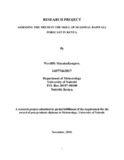| dc.description.abstract | Many socio-economic activities in Kenya are weather and climate dependent. Therefore information on the expected weather is of paramount importance. This information is acquired through use of weather forecasts. The forecasts therefore need to be as accurate and as reliable as possible. How good these seasonal forecasts are can only be determined by assessing the skill of the forecasts.
This study assessed the trend in the skill of seasonal rainfall forecast in Kenya for the years from 2008 to 2017 and consequently sought to determine whether there had been an improvement in the forecast skill over the ten year period. Themonthly rainfall data for twenty years and seasonal rainfall forecasts used in the study were obtained from the Kenya Meteorological Department (KMD). Both graphical and statistical methods were applied in the analyses. The area of study (Kenya) was divided into 12 rainfall homogeneous zones and one meteorological station selected purposively to represent each zone. Long Term Means for each station were determined from which categories were determined as below normal (<75%of LTM) near normal (>75%LTM<125%) And above normal (>125%LTM).The observed rainfall data and seasonal forecasts obtained were used to create 3 by 3 contingency tables for each homogeneous rainfall region which were then used to compute the following statistics; the Probability Of Detection (hit rate) , Heidke Skill Scores, Probability of Detection , False Alarm Ratio and Bias which were then used to assess the forecast skill.
The study showed that for MAM season,the seasonal forecasts were found to be at least 40 % correct which is a modest score. The HSS ranged from a negative value (regions one, six and twelve) to a score of 0.25. This indicates that for the in some regions the standard forecast (chance) is more accurate than the seasonal forecast ,In some regions the score was zero indicating lack of skill while other regions had e very low score regions indicating a low forecast skill. This was also the same for the OND season.
There also was a bias towards forecasting the BN category for the MAM season while the AN category is overforecast in the OND season
xi
In general, the forecast skill was found to be low for both seasons throughout the study period. It also fluctuated from year to year and when an improvement from the previous year was registered, it was modest. | en_US |



